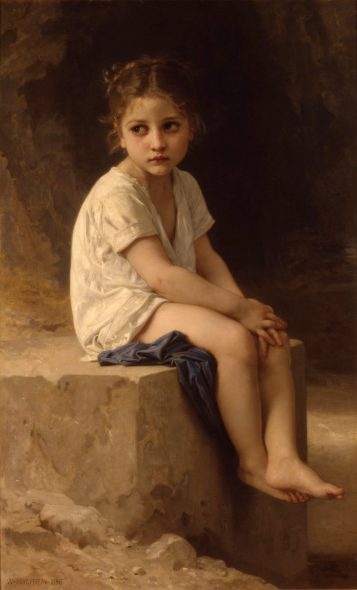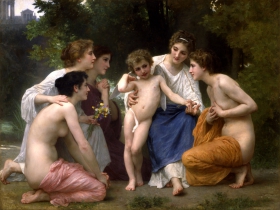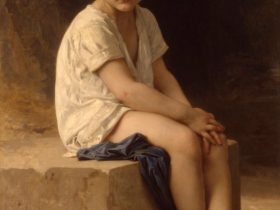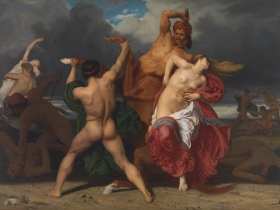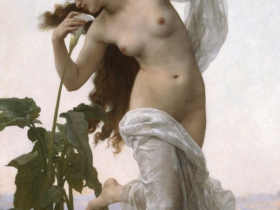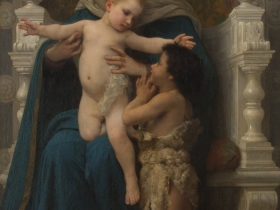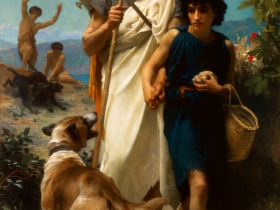Bouguereau the Family Man
Yes, he was old-fashioned, but Art Museum exhibition shows his humanism and terrific technique.
William-Adolphe Bouguereau outlived 4 of his 5 children. Nellie Monchablon, his first wife and the mother of his children, died at the age of 40. She was his 19-year-old model and for a decade they lived together in secret. Three children were born before the couple wed in 1866 and eight days after the marriage their youngest child died of tuberculosis. In 1876 Nellie had their fifth child, but both she and the child died the following year.
As I walk though Bouguereau in America show at the Milwaukee Art Museum and see painting after painting of women with children, many figures floating as mythological or angelic figures, I have a different perspective on an artist who I once chalked up as inconsequential and old-fashioned compared to his revolutionary Impressionistic rivals. Knowing his history gives me a better understanding of why his work is full of living, sensually painted flesh rather than the bright, symbolic colors and thick, rough brushstrokes of such Impressionistic contemporaries as Gaugin or Van Gogh.
For the most part, Bouguereau was a painter of idealized beauty serving either mythological, social or religious ends. But inside these confines is a profoundly human painter. Seldom has there been a square foot of canvas as soft and squishy as the sleeping Christ child in the arms of a ravishingly painted Madonna in “Song of the Angles”. I was struck by the psychological pull of the portraits of his aunt and uncle: both stare at us with a such power in their simplicity and magnetism in their gaze. The way the hands are painted in “Dream of Spring” are as expressive as the daydreaming gaze of the young woman surrounded by three young putti, floating around her head like the birds around the cartoon character hit in the head by an oversized mallet. Bouguereau was a tremendous technician and we feel the blood pulse in the veins under the skin and the folds of the dress flow and stretch against bent legs.
If Bouguereau was seen as old-fashioned in his treatment of the figure and his subject matter, just look at the edges of the paintings; the delicately dancing touches of paint that make up the foliage around the figures in “Flight of Love” embody the emotion the figures depict. It’s easy to overlook the beautiful looseness of paint handling in the weeds next to the dramatic outstretched hand of a satyr or the masterfully troweled paint that forms the rocks next to a buxom breast. In the best paintings we witness opulent manifestations of flesh floating in a vacuum, fabric flowing as though underwater and the lightness of sensuality frozen in a moment of magic.
Other paintings, such as “Rest” or “The Virgin of the Lamb”, seem pieced together as though the figures were cut out and pasted on a background, but for the most part Bouguereau convinces.
In the mammoth painting “Nymphs and Satyr” we see a tornado of flesh and compositional movement. The way the bodies are positioned creates a push-pull of erotic forces, the nymphs pulling the resisting satyr into the lake, his hoof pressing and swelling the soft wet sand underfoot. These paintings evoke many emotions in a confined space. Lust and sensuality mingle with innocence and youth. No painting embodies this more than “Return of Spring” whose model gazes at us with slightly parted lips and head sensually tilted back while surrounded by pre-pubescent putti. A strange combination of emotions are evoked, possibly why a young man threw a chair though this painting during an exhibition in Omaha in 1890. It continued to be exhibited in several US cities with two large gashes in it before being returned to the artist for repair.
Bouguereau took refuge in his work as a way to repair his life and escape the heartbreak of death. “Each day I go to my studio full of joy; in the evening when obliged to stop because of darkness I can scarcely wait for the next morning to come…if I cannot give myself to my dear painting I am miserable.”
Bouguereau & America Gallery
Bouguereau & America, through May 12, at the Milwaukee Art Museum, 700 N. Art Museum Dr., Milwaukee, WI
Art
-
Exhibit Tells Story of Vietnam War Resistors in the Military
 Mar 29th, 2024 by Bill Christofferson
Mar 29th, 2024 by Bill Christofferson
-
See Art Museum’s New Exhibit, ‘Portrait of the Collector’
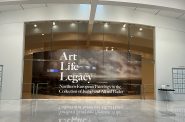 Sep 28th, 2023 by Sophie Bolich
Sep 28th, 2023 by Sophie Bolich
-
100 Years Of Memorable Photography
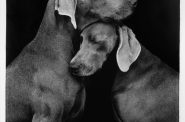 Sep 18th, 2023 by Rose Balistreri
Sep 18th, 2023 by Rose Balistreri



